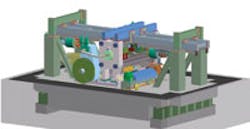A New, Simplified Concept in Pre-Forming
Lasco Umformtechnik GmbH — the developer of various metal forming equipment lines — reports that it recently commissioned its first AR-D 320 pre-forming line at its plant in Coburg, Germany. Touted as an “economic alternative to radial forging lines and traditional open-die forging presses” that use a manipulator, it was designed as an incremental forging operation.
The AR-D typically preforms billets for producing front axles of trucks and crankshafts, but it also can produce preforms for complex parts in one forging temperature, and simple parts can be forged right after pre-forming. Lasco developed the line in the hope that it could produce complex pre-forms from standard semi-finished products, with easy-to-produce, reasonably priced tools. The focus of the production is on speed, high-precision finished parts, and energy efficiency.
Another factor influencing the design is that as forgings gain in size and weight, the number of pieces produced simultaneously decreases. The AR-D can be programmed conveniently for the shape of the parts to be produced, and store the data for further use. This line was designed to produce a variety of different workpieces without time-consuming tool changes.
According to Lasco, the operation can be divided into two main parts, the forming unit and the two manipulators. The forming unit is a horizontal press with two rams moving toward each other, driven hydraulically and performing a sinusoidal motion. The ram movement is not realized via valve control. Instead, the hydraulic system works without any pulsation and at extremely high efficiency. The electric servo motors and hydraulic pumps are combined and allow dynamic adjustment of the ram stroke position so that parts with a variety of contours can be produced.
With a forming force of 3,200 kN per forming die and stroke frequency of 200 strokes/minute, and two rams providing surfaces for attaching two different forming tools (for rectangular or round cross sections), any necessary tool changes can be done in less than 10 seconds.
The two manipulators are driven by servo motors, effectively producing feed motions of up to 60 mm between two forming operations. They are suspended in guide rails and can be programmed to operate in master/slave mode. They transfer the billet from one side to the other, forming both ends of the billet. In the case of long parts, the second manipulator can be used as support to prevent the billet from unintended bending. Exact laser measurement allows the acquisition of the actual length of the workpiece, and a possible correction of the gripper position of the individual slave manipulator.
Lasco has delivered this line to a customer who is hot forming high-alloyed steels into billets with maximum dimensions of 220220 mm, with a maximum weight of 200 kg. Pre-formed parts may have a maximum length of 1,700 mm. The AR-D line also may be used as an alternative to forging rolls, radial forging lines, open-die forging lines, and traditional stretching lines.
